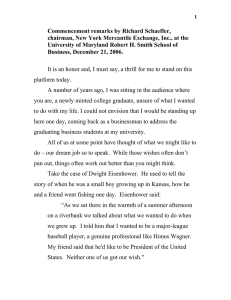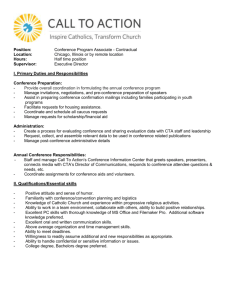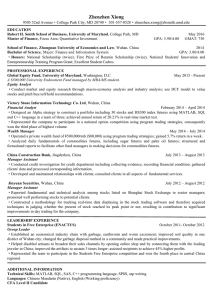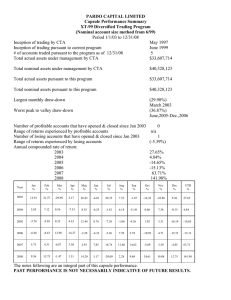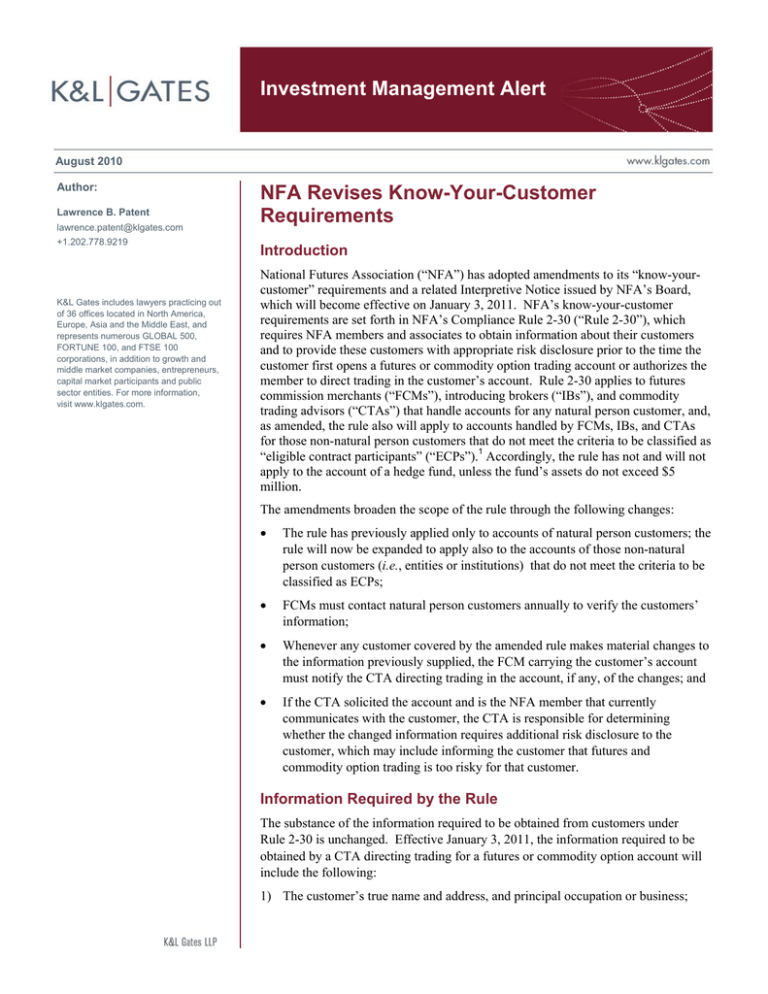
Investment Management Alert
August 2010
Author:
Lawrence B. Patent
lawrence.patent@klgates.com
+1.202.778.9219
K&L Gates includes lawyers practicing out
of 36 offices located in North America,
Europe, Asia and the Middle East, and
represents numerous GLOBAL 500,
FORTUNE 100, and FTSE 100
corporations, in addition to growth and
middle market companies, entrepreneurs,
capital market participants and public
sector entities. For more information,
visit www.klgates.com.
NFA Revises Know-Your-Customer
Requirements
Introduction
National Futures Association (“NFA”) has adopted amendments to its “know-yourcustomer” requirements and a related Interpretive Notice issued by NFA’s Board,
which will become effective on January 3, 2011. NFA’s know-your-customer
requirements are set forth in NFA’s Compliance Rule 2-30 (“Rule 2-30”), which
requires NFA members and associates to obtain information about their customers
and to provide these customers with appropriate risk disclosure prior to the time the
customer first opens a futures or commodity option trading account or authorizes the
member to direct trading in the customer’s account. Rule 2-30 applies to futures
commission merchants (“FCMs”), introducing brokers (“IBs”), and commodity
trading advisors (“CTAs”) that handle accounts for any natural person customer, and,
as amended, the rule also will apply to accounts handled by FCMs, IBs, and CTAs
for those non-natural person customers that do not meet the criteria to be classified as
“eligible contract participants” (“ECPs”).1 Accordingly, the rule has not and will not
apply to the account of a hedge fund, unless the fund’s assets do not exceed $5
million.
The amendments broaden the scope of the rule through the following changes:
•
The rule has previously applied only to accounts of natural person customers; the
rule will now be expanded to apply also to the accounts of those non-natural
person customers (i.e., entities or institutions) that do not meet the criteria to be
classified as ECPs;
•
FCMs must contact natural person customers annually to verify the customers’
information;
•
Whenever any customer covered by the amended rule makes material changes to
the information previously supplied, the FCM carrying the customer’s account
must notify the CTA directing trading in the account, if any, of the changes; and
•
If the CTA solicited the account and is the NFA member that currently
communicates with the customer, the CTA is responsible for determining
whether the changed information requires additional risk disclosure to the
customer, which may include informing the customer that futures and
commodity option trading is too risky for that customer.
Information Required by the Rule
The substance of the information required to be obtained from customers under
Rule 2-30 is unchanged. Effective January 3, 2011, the information required to be
obtained by a CTA directing trading for a futures or commodity option account will
include the following:
1) The customer’s true name and address, and principal occupation or business;
Investment Management Alert
2) For customers who are individuals, the
customer’s current estimated annual income and
net worth -- for all other customers, the
customer’s net worth or net assets and current
estimated annual income, or, where not
available, the previous year’s annual income;
3) For individuals, the customer’s approximate age
or date of birth;
4) An indication of the customer’s previous
investment and futures trading experience; and
5) Such other information deemed appropriate for
determining the disclosures to make to the
customer regarding the risks of futures trading.
In addition, CTAs that are not also members of the
Financial Industry Regulatory Authority (“FINRA”)
must obtain the following information from each
customer who is an individual if the customer trades
security futures products:2
6) Whether the customer’s account is traded for
speculative or hedging purposes;
7) The customer’s employment status (e.g., name
of employer, self-employed, retired);
8) The customer’s estimated liquid net worth (cash,
securities, other);
9) The customer’s marital status and number of
dependents; and
10) Such other information used or considered to be
reasonable by the CTA in making
recommendations to the customer.3
Customers Covered by the Rule
Rule 2-30 was first adopted almost 25 years ago and
has historically applied only to natural person
customers. The customers that will be covered by
Rule 2-30, effective January 3, 2011, have been
expanded to include any non-natural person
customer that does not qualify as an ECP.
Currently, CTAs that manage accounts must obtain
customer information from any natural person
customer, even if that individual would be classified
as an ECP because his or her total assets exceed $10
million.4 The amendments to Rule 2-30 will require
CTAs that manage accounts opened on and after
January 3, 2011, and which were solicited by the
CTA,5 to obtain the first five items of required
information described above from non-natural
persons that do not qualify as ECPs under the CEA.
These persons could include commodity pools
whose assets do not exceed $5 million, or an entity
that (1) has assets that do not exceed $10 million,
(2) does not have its obligations guaranteed by
certain other ECPs, and (3) (a) whose net worth
does not exceed $1 million, or, (b) if its net worth
does exceed $1 million but it otherwise satisfies
conditions (1) and (2), it is not entering into futures
or commodity option contracts in connection with
the operation of its business or to manage the risk
associated with an asset owned or a liability
incurred, or reasonably likely to be owned or
incurred, by the entity in the operation of its
business. Non-natural persons that do not qualify as
ECPs under the CEA also include certain
governmental entities. Specifically, the United
States, a State, or a foreign government, a political
subdivision of any of those government entities, an
instrumentality, agency, or department of any of the
foregoing, as well as an instrumentality, agency, or
department of a multinational or supranational
governmental entity, will not qualify as an ECP
under the CEA unless it owns and invests on a
discretionary basis at least $25 million in
investments (which amount Dodd-Frank raises to
$50 million next July),6 provided that it does not
separately meet certain of the criteria that would
qualify it as an “eligible commercial entity”
(“ECE”) under the CEA.7
Updating of Information
FCMs that carry the account of a natural person
who is an active customer8 will be required under
amended Rule 2-30 to contact the customer, at least
annually, to verify the information that the customer
has previously supplied. Because the amendments
become effective on January 3, 2011, FCMs will
have the remainder of 2011 to conduct the update
process, which must then be repeated on an annual
basis. Any customer, including a non-natural
person, non-ECP customer, may notify the FCM at
any time of material changes to its customer
information. Whenever that occurs, if the trading in
the account is being directed by a CTA, the FCM
must notify the CTA of the changes to the
customer’s information. At that point, a
determination must be made as to whether
additional risk disclosure must be provided to the
August 2010
2
Investment Management Alert
customer based upon the changed information. If
the CTA solicited the account and is still in
communication with the customer, the CTA must
make that determination. The revised Interpretive
Notice makes it clear that, if the updated information
provided by the customer indicates that futures or
commodity option trading is too risky for the
customer, the only adequate risk disclosure by the
CTA is that futures and commodity option trading is
too risky for that customer. The revised Interpretive
Notice also states that, once the customer has been
given adequate disclosure, the customer is free to
make the decision whether to continue to trade
futures and commodity options, and NFA members
are permitted to continue to handle the account. The
revised Interpretive Notice further states that
“Members and Associates, however, are prohibited
from making individualized recommendations to any
customer for which the Member or Associate has or
should have advised that futures trading is too risky
for that customer.” Therefore, if a CTA is directing
the trading for a customer pursuant to a power of
attorney, and the CTA is notified of updated
information about the customer that causes the CTA
to conclude, and it so informs the customer, that
futures and commodity option trading is too risky
for that customer, the CTA must carefully consider
whether it can continue to direct trading in the
customer’s account in accordance with the power of
attorney, even if the customer believes that it should
remain in the futures and option market.9
Background of Rule Amendments
In its explanation of the amendments to Rule 2-30
and the related Interpretive Notice, which
accompanied NFA’s request for CFTC review and
approval thereof, NFA noted that part of the impetus
for the amendments was the CFTC-SEC joint public
meetings on regulatory harmonization held in early
September 2009. At these meetings, one of the
many topics discussed was the futures industry’s
know-your-customer requirements and the securities
industry’s suitability requirements.
Following these meetings, NFA’s Executive
Committee asked NFA’s Advisory Committees to
consider whether Rule 2-30 could be amended to
further enhance customer protection. In their
review, the Advisory Committees noted that the
futures industry differs from the securities industry
in several crucial ways. Futures contracts in general
are recognized as highly volatile instruments, so it
therefore makes little sense to presume that a certain
type of futures trade may be appropriate for a
customer while others are not. This is to be
contrasted with securities trading, where the range
of instruments (e.g., equities, bonds, municipal
securities) have different risk profiles and therefore
a portfolio may more readily be matched to a
customer’s circumstances and preferences. The
Advisory Committees also noted that an
appreciation of the risks of futures and commodity
option trading and its appropriateness for a
particular customer must be made at the time the
customer makes a decision to trade futures in the
first place, and therefore the Committees fully
supported maintaining the essential character of
Rule 2-30’s know-your-customer requirement as a
customer-by-customer determination.
NFA’s Advisory Committees were also in general
agreement that Rule 2-30 currently works well and
provides strong customer protection. Further, they
believed that NFA’s know-your-customer
requirements and FINRA’s suitability rules address
the same concerns and achieve substantially the
same results, and that any differences between them
are largely semantic. The Committees noted,
however, that certain modifications to Rule 2-30
would provide increased customer protection and,
therefore, they supported the amendments described
herein.
Conclusion
CTAs that direct trading in customer accounts will
have some additional responsibilities under
Rule 2-30 when the amendments to that rule
become effective on January 3, 2011. If the CTA
solicits the account of a non-natural person that does
not qualify as an ECP under the CEA, the CTA
must obtain certain information about the customer
(name and address; principal occupation or
business; net worth or net assets and current
estimated annual income or, if that is not available,
the previous year’s income; and previous
investment and futures trading experience). If this
information changes in any material way, the CTA
must determine if additional risk disclosure must be
provided to the customer based upon the revised
information, which could include telling the
customer that futures and option trading is too risky.
If the CTA so informs the customer, the CTA must
August 2010
3
Investment Management Alert
carefully consider whether it can continue to direct
trading in the customer’s account in accordance with
the power of attorney granted by the customer, even
if the customer believes that it should remain in the
commodity futures and option market.
Anchorage Austin Beijing Berlin Boston Charlotte Chicago Dallas Dubai Fort Worth Frankfurt Harrisburg Hong Kong London
Los Angeles Miami Moscow Newark New York Orange County Palo Alto Paris Pittsburgh Portland Raleigh Research Triangle Park
San Diego San Francisco Seattle Shanghai Singapore Spokane/Coeur d’Alene Taipei Tokyo Warsaw
Washington, D.C.
K&L Gates includes lawyers practicing out of 36 offices located in North America, Europe, Asia and the Middle East, and represents numerous
GLOBAL 500, FORTUNE 100, and FTSE 100 corporations, in addition to growth and middle market companies, entrepreneurs, capital market
participants and public sector entities. For more information, visit www.klgates.com.
K&L Gates comprises multiple affiliated entities: a limited liability partnership with the full name K&L Gates LLP qualified in Delaware and
maintaining offices throughout the United States, in Berlin and Frankfurt, Germany, in Beijing (K&L Gates LLP Beijing Representative Office), in
Dubai, U.A.E., in Shanghai (K&L Gates LLP Shanghai Representative Office), in Tokyo, and in Singapore; a limited liability partnership (also named
K&L Gates LLP) incorporated in England and maintaining offices in London and Paris; a Taiwan general partnership (K&L Gates) maintaining an
office in Taipei; a Hong Kong general partnership (K&L Gates, Solicitors) maintaining an office in Hong Kong; a Polish limited partnership (K&L
Gates Jamka sp.k.) maintaining an office in Warsaw; and a Delaware limited liability company (K&L Gates Holdings, LLC) maintaining an office in
Moscow. K&L Gates maintains appropriate registrations in the jurisdictions in which its offices are located. A list of the partners or members in each
entity is available for inspection at any K&L Gates office.
This publication is for informational purposes and does not contain or convey legal advice. The information herein should not be used or relied upon
in regard to any particular facts or circumstances without first consulting a lawyer.
©2010 K&L Gates LLP. All Rights Reserved.
ranking rules for certain securities that have an equal
weighting.
1
An ECP is defined in the Commodity Exchange Act
(“CEA”) to include a financial institution, an insurance
company, or an investment company. In addition, an ECP
includes a commodity pool, corporation or other legal entity,
an employee benefit plan, governmental entity, or certain
other types of entities and individuals, in each case having
a minimum amount of assets, net worth or investments, as
applicable, or meeting other specified requirements. CEA
Section 1a(12), 7 U.S.C. §1a(12). The recently-enacted
financial regulatory reform legislation, the Dodd-Frank Wall
Street Reform and Consumer Protection Act (“DoddFrank”), redesignates the ECP definition, effective July 16,
2011, as CEA Section 1a(18), which will be codified at 7
U.S.C. §1a(18), and makes certain substantive
amendments thereto discussed more fully below.
3
2
5
The security futures related information must be obtained
only from a natural person customer, not also from the nonnatural person, non-ECP customers for which the first five
items listed above must be obtained. Security futures
products are futures on an individual equity security or a
narrow-based security index, and are subject to joint
jurisdiction of the Commodity Futures Trading Commission
(“CFTC”) and the Securities and Exchange Commission
(“SEC”). The term “narrow-based security index” is
generally defined as an index: (i) that has nine or fewer
component securities; or (ii) in which a component security
comprises more than 30 percent of the index’s weighting;
or (iii) in which the five highest weighted component
securities, in the aggregate, comprise more than 60 percent
of the index’s weighting; or (iv) in which the lowest
weighted component securities comprising, in the
aggregate, 25 percent of the index’s weighting, have an
aggregate dollar value of average daily trading volume of
less than $50 million (or in the case of an index with 15 or
more component securities, $30 million), with special
FINRA requires that its members obtain the information
referred to herein with respect to security futures customers
who are natural persons. See FINRA Rule 2370(b)(16)(B).
4
Dodd-Frank changes the basic criterion for determining
whether an individual is an ECP from having total assets in
excess of $10 million to having that dollar amount invested on
a discretionary basis. Dodd-Frank did not amend the
alternative criterion for an individual to be classified as an ECP
under the CEA, which requires $5 million in total assets and
entering into an agreement, contract or transaction to manage
the risk associated with an asset owned or a liability incurred,
or reasonably likely to be owned or incurred. This change is
irrelevant for purposes of Rule 2-30, however, which continues
to apply to any natural person customer.
CTAs may direct the trading for customers that they did not
solicit. An FCM may not want to manage accounts in-house,
and if it solicits a customer that wants someone else to make
the trading decisions for its account, the FCM might assign a
CTA from the FCM’s “approved list” of outside CTAs to manage
the account. Because the CTA did not solicit this customer, it
would be the responsibility of the FCM to obtain the required
customer information.
6
The multinational or supranational governmental entity (e.g.,
the United Nations), itself is automatically an ECP without the
need to maintain a certain level of investments.
7
The criteria that would make a governmental entity, or an
instrumentality, agency, or department of a governmental
entity, an ECE under the CEA are that it, with respect to an
agreement, contract or transaction in a commodity, (i) has a
demonstrable ability, directly or through separate contractual
arrangements, to make or take delivery of the underlying
commodity; (ii) incurs risks, in addition to price risk, related to
the commodity; or (iii) is a dealer that regularly provides risk
August 2010
4
Investment Management Alert
management or hedging services to, or engages in marketmaking activities with, certain types of ECPs involving
transactions to purchase or sell the commodity, or
derivative agreements, contracts, or transactions in the
commodity. See CEA Sections 1a(11)(A)(i)-(iii) and
1a(12)(A)(vii), which will be redesignated by Dodd-Frank as
Sections 1a(17)(A)(i)-(iii) and 1a(18)(A)(vii) effective July
16, 2011.
8
An active customer is a customer entitled to a monthly
statement under CFTC Regulation 1.33(a), 17 C.F.R. §
1.33(a). That regulation requires that a monthly statement
be provided unless there are neither open positions as of
the month-end nor any changes to the account balance
since the prior statement period.
9
Based upon telephone conversations with NFA staff, they
have advised that, although they may not recommend that
disciplinary action be taken against a CTA if the customer
persists in wanting the CTA to continue to direct trading for
the customer in these circumstances, NFA staff auditors
would certainly closely examine any CTA continuing to
direct trading for a customer that the CTA believes should
not be participating in the futures and commodity option
market.
August 2010
5

